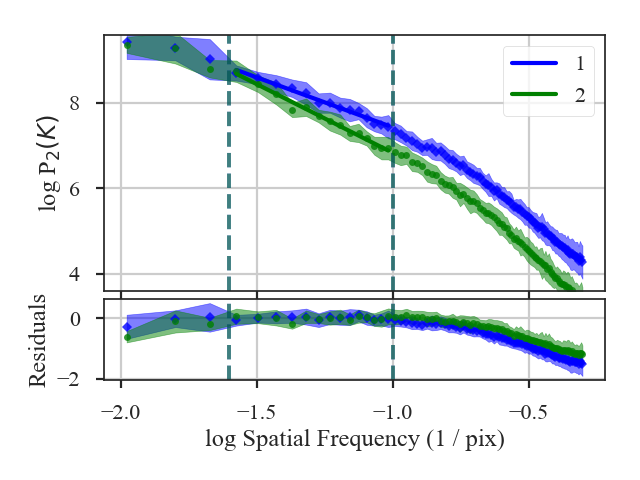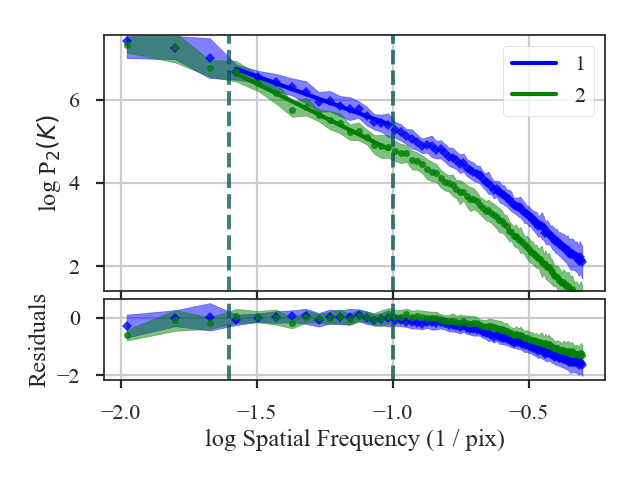VCA Distance¶
See the tutorial for a description of Velocity Channel Analysis (VCA).
The VCA distance is defined as the t-statistic of the difference in the fitted slopes:
\(\beta_i\) are the slopes of the VCA spectra and \(\sigma_{\beta_i}\) are the uncertainty of the slopes.
More information on the distance metric definitions can be found in Koch et al. 2017.
Using¶
The data in this tutorial are available here.
We need to import the VCA_Distance class, along with a few other common packages:
>>> from turbustat.statistics import VCA_Distance
>>> from astropy.io import fits
>>> import matplotlib.pyplot as plt
>>> import astropy.units as u
VCA_Distance takes two data cubes as input:
>>> cube = fits.open("Design4_flatrho_0021_00_radmc.fits")[0] # doctest: +SKIP
>>> cube_fid = fits.open("Fiducial0_flatrho_0021_00_radmc.fits")[0] # doctest: +SKIP
From the VCA tutorial, we know that limits should be placed on the power-spectra. These limits can be specified with low_cut and high_cut:
>>> vca = VCA_Distance(cube_fid, cube, low_cut=0.025 / u.pix,
... high_cut=0.1 / u.pix) # doctest: +SKIP
This will run VCA on the given cubes, which can be accessed as vca1 and vca2.
Additional parameters can be specified to VCA. Different fit limits for the two cubes can be given as a two-element list (e.g., low_cut=[0.025 / u.pix, 0.04 / u.pix]). Estimated break points in the power-spectra can be given in the same format, which will enable fitting with a broken-linear model.
- To find the distance between the cubes:
>>> vca.distance_metric(verbose=True) # doctest: +SKIP OLS Regression Results ============================================================================== Dep. Variable: y R-squared: 0.985 Model: OLS Adj. R-squared: 0.984 Method: Least Squares F-statistic: 436.3 Date: Fri, 16 Nov 2018 Prob (F-statistic): 8.40e-11 Time: 10:16:28 Log-Likelihood: 22.506 No. Observations: 14 AIC: -41.01 Df Residuals: 12 BIC: -39.73 Df Model: 1 Covariance Type: HC3 ============================================================================== coef std err z P>|z| [0.025 0.975] ------------------------------------------------------------------------------ const 5.0853 0.137 37.170 0.000 4.817 5.353 x1 -2.3350 0.112 -20.887 0.000 -2.554 -2.116 ============================================================================== Omnibus: 0.981 Durbin-Watson: 1.483 Prob(Omnibus): 0.612 Jarque-Bera (JB): 0.712 Skew: -0.138 Prob(JB): 0.700 Kurtosis: 1.930 Cond. No. 15.2 ============================================================================== OLS Regression Results ============================================================================== Dep. Variable: y R-squared: 0.986 Model: OLS Adj. R-squared: 0.985 Method: Least Squares F-statistic: 722.3 Date: Fri, 16 Nov 2018 Prob (F-statistic): 4.33e-12 Time: 10:16:28 Log-Likelihood: 18.704 No. Observations: 14 AIC: -33.41 Df Residuals: 12 BIC: -32.13 Df Model: 1 Covariance Type: HC3 ============================================================================== coef std err z P>|z| [0.025 0.975] ------------------------------------------------------------------------------ const 3.6086 0.141 25.636 0.000 3.333 3.884 x1 -3.2136 0.120 -26.876 0.000 -3.448 -2.979 ============================================================================== Omnibus: 13.847 Durbin-Watson: 2.394 Prob(Omnibus): 0.001 Jarque-Bera (JB): 9.666 Skew: -1.631 Prob(JB): 0.00796 Kurtosis: 5.434 Cond. No. 15.2 ==============================================================================

This function returns a summary of the fits to the VCA spectra and plots the two spectra with the fits. Colours, symbols and labels in the plot can be changed with plot_kwargs1 and plot_kwargs2 in distance_metric.
- The distance is:
>>> vca.distance # doctest: +SKIP 5.366955632554179
Changing the width of the velocity channels affects the contribution of the turbulent velocity field to the spectrum, thereby altering the measured index (Lazarian & Pogosyan 2000). It is generally advisable to compare cubes with a similar velocity resolution.
In VCA_Distance, the channel width can be changed with channel_width. The new channel width should be (1) larger than the current channel widths of the cubes, and (2) in similar units to the spectral axis of the cubes (i.e., a width in velocity should be given for a spectral axis in velocity).
Warning
Changing the spectral resolution will be slow for large cubes. Consider changing the velocity resolution of large cubes before running VCA.
In this example, we will change the velocity resolution to 400 m/s:
>>> vca = VCA_Distance(cube_fid, cube, low_cut=0.025 / u.pix,
... high_cut=0.1 / u.pix, channel_width=400 * u.m / u.s) # doctest: +SKIP
>>> vca.distance_metric(verbose=True) # doctest: +SKIP
OLS Regression Results
==============================================================================
Dep. Variable: y R-squared: 0.985
Model: OLS Adj. R-squared: 0.983
Method: Least Squares F-statistic: 419.3
Date: Fri, 16 Nov 2018 Prob (F-statistic): 1.06e-10
Time: 10:16:28 Log-Likelihood: 22.121
No. Observations: 14 AIC: -40.24
Df Residuals: 12 BIC: -38.96
Df Model: 1
Covariance Type: HC3
==============================================================================
coef std err z P>|z| [0.025 0.975]
------------------------------------------------------------------------------
const 3.0105 0.141 21.350 0.000 2.734 3.287
x1 -2.3639 0.115 -20.478 0.000 -2.590 -2.138
==============================================================================
Omnibus: 0.854 Durbin-Watson: 1.515
Prob(Omnibus): 0.652 Jarque-Bera (JB): 0.676
Skew: -0.144 Prob(JB): 0.713
Kurtosis: 1.963 Cond. No. 15.2
==============================================================================
OLS Regression Results
==============================================================================
Dep. Variable: y R-squared: 0.985
Model: OLS Adj. R-squared: 0.984
Method: Least Squares F-statistic: 684.5
Date: Fri, 16 Nov 2018 Prob (F-statistic): 5.94e-12
Time: 10:16:28 Log-Likelihood: 17.855
No. Observations: 14 AIC: -31.71
Df Residuals: 12 BIC: -30.43
Df Model: 1
Covariance Type: HC3
==============================================================================
coef std err z P>|z| [0.025 0.975]
------------------------------------------------------------------------------
const 1.5197 0.146 10.408 0.000 1.234 1.806
x1 -3.2379 0.124 -26.163 0.000 -3.481 -2.995
==============================================================================
Omnibus: 13.778 Durbin-Watson: 2.379
Prob(Omnibus): 0.001 Jarque-Bera (JB): 9.575
Skew: -1.633 Prob(JB): 0.00833
Kurtosis: 5.398 Cond. No. 15.2
==============================================================================

The VCA power-spectra with 400 m/s channels have a similar slope to the original velocity resolution. The distance then has not significantly changed:
>>> vca.distance # doctest: +SKIP
5.164776059129051
A pre-computed VCA class can be also passed instead of a data cube. See the distance metric introduction.